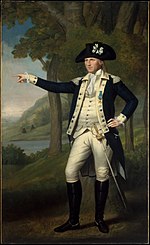Johnson Hall State Historic Site
Biographical museums in New York (state)Historic American Buildings Survey in New York (state)Historic house museums in New York (state)Houses completed in 1763Houses in Fulton County, New York ... and 7 more
Houses on the National Register of Historic Places in New York (state)Museums in Fulton County, New YorkNational Historic Landmarks in New York (state)National Register of Historic Places in Fulton County, New YorkNew York (state) historic sitesNew York State Register of Historic Places in Fulton CountyUse mdy dates from August 2023

Johnson Hall State Historic Site was the home of Sir William Johnson (1715–1774) an Irish pioneer who became the influential British Superintendent of Indian Affairs in the Province of New York, known for his strong relationship especially with the Mohawk and other Iroquois League nations. Johnson Hall is located at Hall Avenue, West State Street and Johnson Avenue, in Johnstown, New York.
Excerpt from the Wikipedia article Johnson Hall State Historic Site (License: CC BY-SA 3.0, Authors, Images).Johnson Hall State Historic Site
Johnson Hall State Park Foot Path,
Geographical coordinates (GPS) Address Nearby Places Show on map
Geographical coordinates (GPS)
| Latitude | Longitude |
|---|---|
| N 43.015 ° | E -74.382777777778 ° |
Address
Johnson Hall State Park Foot Path
Johnson Hall State Park Foot Path
12095
New York, United States
Open on Google Maps








